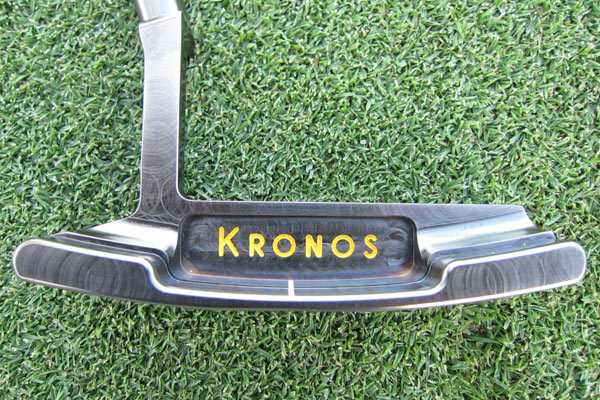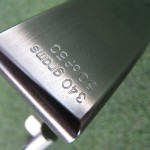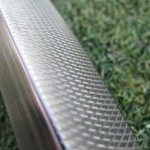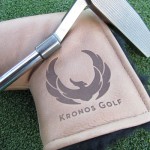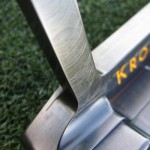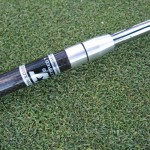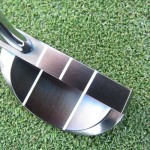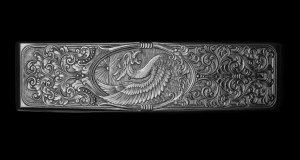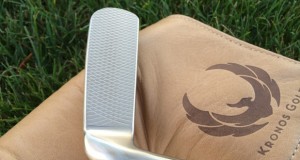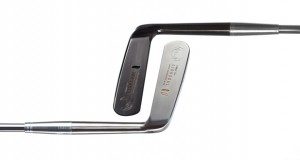A chance encounter led to one of PutterZone.com’s most intriguing discoveries in 2012 when we met the entrepreneurs behind Kronos Golf at the PGA Expo’s “Demo Day” in Las Vegas last summer.
There, Kronos founders Mike Buchfuhrer and Phillip Lapuz kindly opened the trunk of their car to reveal the working prototypes of their two inaugural putters, specifically the Kronos Touch blade putter ($350) and Kronos Metronome mallet putter ($330).
Now, both putters have been officially launched for 2013, making Kronos the latest player on the increasingly crowded artisan putter scene. Do Kronos putters travel down the beaten path, or do they blaze new trails?
Following is PutterZone.com’s Kronos putter review, with a focus on the Kronos Touch blade putter.
The Storyline
Both the Touch and Metronome putters are precision milled from 11L17 carbon steel in San Diego County, California—the epicenter of the clubmaking industry. There, Lapuz learned the putter milling craft at the machine shop of a friend’s father, who produced putters for brands both big and small. Lapuz later joined forces with Buchfuhrer to launch Kronos Golf, which they say is founded upon several guiding principles.
“We want to redefine precision by milling to a new standard,” Lapuz says. “We feel a milled putter should look like it just came out of the mill, not like it was just buffed and ground, which is a much less precise method… Details are everything in a precision putter. We never weld, cast or stamp. Welding corrupts the integrity of a solid piece. Stamping deforms the metal. Using a hammer to restructure the surface of a precision instrument is not something we’re willing to do.”
Adds Buchfuhrer, “We’re not into gimmicks. We aim to make putters people will enjoy and fall in love with.”
Both the Touch and Metronome putters share several defining characteristics. The thick toplines on both putters “put mass where it belongs—behind the ball. We want well-struck putts to feel solid and the thick topline accomplishes this.”
Both putters also feature a “compass scored” face milling pattern (see accompanying photos) which is designed to achieve “a more uniform pattern of diamonds for a more uniform face than what you see out there today.”
The attentive golfer will also notice that the single sightline on the flange of the Touch blade is visually off center, ever so slightly closer to the heel than the toe. This, too, is by design: “A properly placed sightline indicates the center of mass, and thus the sweet spot of the putter. The vast majority of putters do not do this. It’s the equivalent of having the ‘X’ misplaced on a treasure map, how maddening! We take great pains in our quality control to ensure that our sightlines are directly in line with the sweet spot.”
Fitting Factors
The Touch is a heel-toe weighted blade. The head weight is your choice of 340 or 350 grams, with 360 grams coming soon. The loft is three degrees, the lie angle is 71 degrees, and the sole draft is two degrees. Length can be customized. The toe hang is fairly deep at 3/4, meaning that it will likely appeal most to golfers with an arcing stroke.
The Metronome (360 or 370 grams, 70 degree lie angle, two degrees loft) is a traditional half-moon mallet with dual flange sightlines that frame the ball, and that are visually continued along the topline. According to Kronos, “The continuation of the sightlines from topline to flange allows the golfer to see whether he has his eyes over the ball—or the degree to which he doesn’t .” The Metronome is face balanced, and coupled with the eyes-over-the-ball alignment feature, it will appeal to golfers with a straight-back-and-through stroke.
(For more on how to use putter fitting to raise your game, check out our acclaimed putter fitting guide)
The View from PutterZone.com
Kronos Golf is the rookie who steps up to the plate and knocks the first pitch out of the park. Simply put, these putters are phenomenal, and not just because they offer exceptional quality from head to headcover—but also because they present a clear point of view. Every detail seems to be well thought out, creating a rare sense of purposefulness.
True to its name, the Touch blade offers a lush feel off the face. The sensation at contact is thick, plump and rewarding. There’s a solidness at the core for ample feedback, yet it steers safely clear of hardness. A well-struck ball feels as if it’s being ever so slightly hugged before being sent on its way.
The feel of the Touch is enhanced by the putter’s UST Frequency Filtered shaft, which is designed to dampen unwanted vibrations while clarifying overall feedback. This shaft adds a unique look to the putter as well, with black carbon butt that tapers into traditional steel.
Meanwhile, the alignment feature on the Metronome mallet is ingenious yet simple—the outer lines on the crown create a seamless connection with the lines on the flange when your eyes are directly over the ball and putter head. When the lines visually interlock, there’s an “aha” moment, and you can be assured that your setup is consistent from one putt to the next (the accompanying photo doesn’t do the alignment feature justice, the camera couldn’t quite capture the the complete effect).
The “eyes over the ball” setup is a longtime pillar of putting instruction. It’s worth noting that some top instructors such as Stan Utley, however, prefer that you have your eyes slightly inside the line and not directly over the ball. You will want to verify that your natural setup position is to have your eyes over the ball before your rush headlong into acquiring the Metronome.
There’s a luxuriousness to the look of both the Touch and Metronome putters. The “silver pearl” PVD finish strikes a cool balance between light and dark. The exposed milling marks exude a sense of craftsmanship, and little touches—such as the rainbow flaming around the Kronos name in the cavity of the Metronome—add a touch of elegance.
Kronos is clearly honoring the classics with their Anser-style blade and half-moon mallet, which are two of the most iconic base shapes in the putter world. But the discerning golfer will also notice numerous proprietary nuances incorporated into the design of the Kronos putters—such as the balance of both sharp and curvaceous cornering in the Touch, and the fine tapering flow of the Metronome.
The thicker toplines jump out as the most obvious break with tradition. The idea is to put more mass behind the ball for a rich, solid feel—and I would say that they hit the mark in that department. Not every golfer will embrace the look, but it’s hard not to appreciate the results. Also, some golfers will find the thicker topline to convey visual stability and confidence at setup.
Flashy graphics and splashy logos have become the norm in putter fashion these days. Kronos putters, however, buck this trend, exuding an almost cocky minimalism. The stock grip is a black Iomic grip without any Kronos branding. Logos and paintfill are held to a bare minimum, and there is nothing to distract you from the task at hand. Some golfers will be left wanting more in the stylization department, while others will embrace the classicism of the Kronos aesthetic.
Meanwhile, the included putter cover is a piece of awesomeness. Rather than buy a third-party cover and slap a logo on it, they have produced their own full-grain leather cover, with the Kronos logo literally branded into it with a hot branding iron. The result is a joy to behold.
The Bottom Line
Sometimes it’s the next generation that is best equipped to lead us back to our roots. Helmed by a couple of young entrepreneurs, Kronos Golf is a throwback to the days when substance reigned supreme. At the same time, Kronos putters exhibit a fresh point of view and an innovative approach to quality. As such, Kronos putters are poised to join the ranks of the elite putter market.
 PutterZone – Best Putter Reviews
PutterZone – Best Putter Reviews
